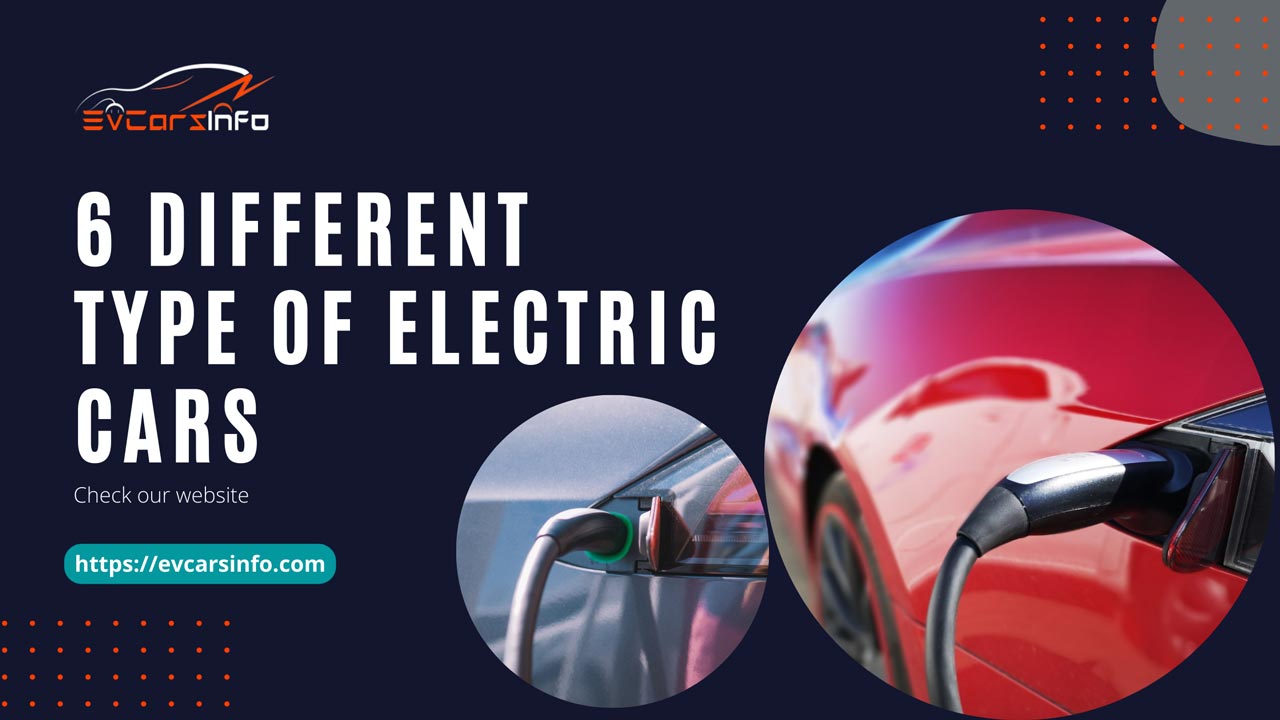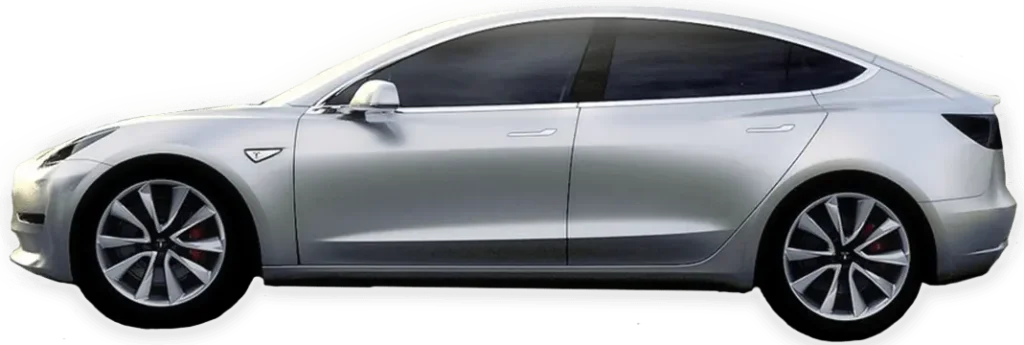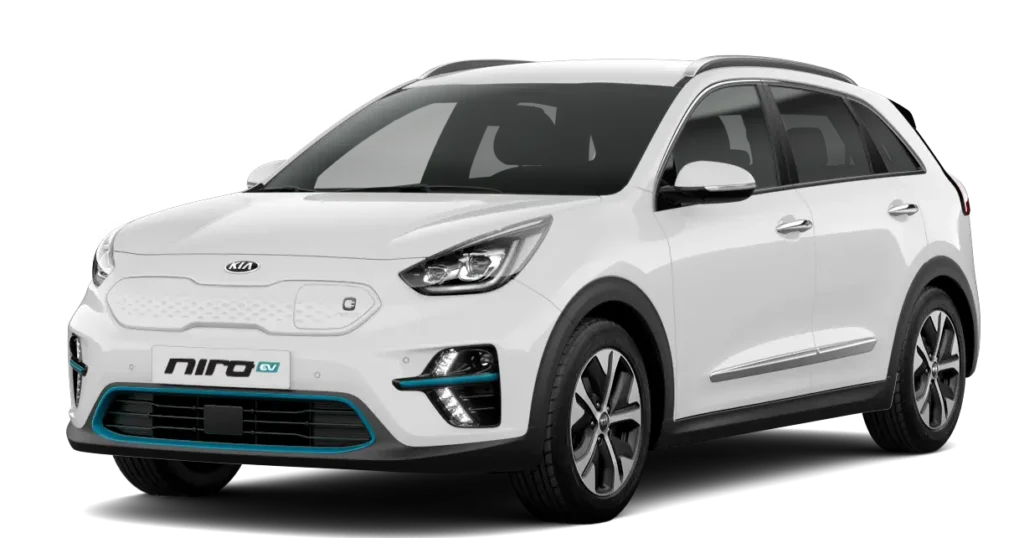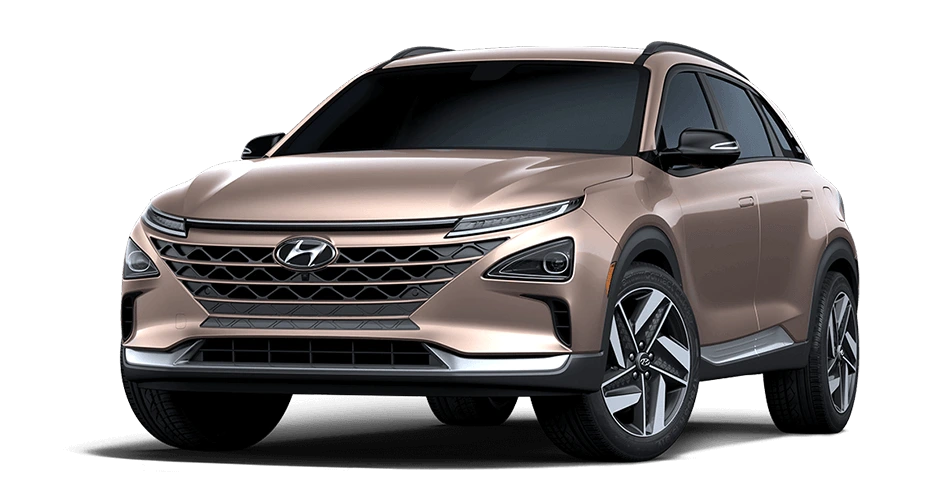

6 Different Type of Electric Cars
An electric vehicle, such as an electric car, uses one or more electric motors powered by a battery pack to accelerate and drive. Depending on the type of Electric Car, the electric motor(s) either assist a conventional internal combustion engine (ICE) or power the car completely.
Contents
hide
Type of Electric Car
There are 6 types of electric cars. Such as: EV, HEV, PHEV, MHEV, FCEV, REx.
1. Type of Electric Car is: Electric Vehicle (EV)

A simple electric vehicle (EV) uses electric motors and a massive battery to provide propulsion. There is no petrol or diesel engine at all, and all power for the vehicles comes from the battery pack, which can be recharged either at home and work or at public charge points. While electric vans, buses, scooters, and lorries are technically EVs, the term is used synonymously to mean electric cars.
Electric Vehicle (EV) Pros and Cons.
| Pros | Cons |
| Electricity costs less than gasoline.No gears to shift makes it simple to driveMaintenance fees may be minimal. | Compared to filling a tank, charging is slower and less convenient.Prices are typically greater than traditional gasoline and diesel vehicles.Driving range on a full charge is inferior to gasoline and diesel vehicles. |
2. Type of Electric Car is: Electric Hybrid Vehicle (HEV)

Small electric motors and rechargeable batteries are features of hybrid electric vehicles with an internal combustion engine. HEVs, a type of electric car often known as self-charging hybrids, have a machine that kicks in when accelerating hard or while traveling above a mile or less). Popular HEVs include the Kia Niro, Suzuki Ignignis, and Toyota Prius. HEVs are reasonably priced and excellent for commuting in cities.
Electric Hybrid Vehicle (HEV) Pros and Cons.
| Pros | Cons |
| Cheaper than PHEVs or EVs in priceGenerally uses less fuel than standard petrol/diesel vehiclesSupplementary devices can be powered by electric components, which can also improve acceleration. | Depending on the driving environment, fuel economy advantages can change.Most models have a very restricted electric rangeTax advantages are negligible in comparison to pure EVs. |
3. Type of Electric Car is: Plug-in Hybrid Electric Vehicle (PHEV)

A plug-in type of electric car is a hybrid vehicle that combines a gasoline or diesel internal combustion engine with an electric motor and battery. A PHEV can generally travel between 20 and 70 miles (ca. 113 kilometers) in electric mode at speeds up to 80 mph (ca. 129 kilometers per hour). Its battery is smaller than an EV’s but more extensive than a standard hybrid’s. A PHEV’s battery can also be plugged in and recharged, in addition to receiving power from the engine and using energy recovered during braking. Today’s popular PHEVs include the Volvo XC60 Recharge, BMW 330e, and Mercedes C 300e.
A PHEV is excellent for short-distance pure electric driving, but it may be necessary to drive to locations where charging is only sometimes feasible or practical. For additional information, see our comprehensive PHEV guide.
Plug-in Hybrid Electric Vehicle (PHEV) Pros and Cons.
| Pros | Cons |
| Not entirely dependent on the infrastructure for electric charging and battery rangeCan be more affordable than pure EVs and operate primarily on battery power if a daily trip is brief. | Running costs may go up with more complexity.Any savings from not charging the battery are lost.Cost more than a comparable gasoline/diesel vehicle |
4. Type of Electric Car is: Mild Hybrid Electric Vehicle (MHEV)

Another type of electric car is the Mild Hybrid Electric Vehicle (MHEV). A typical gasoline or diesel vehicle called an MHEV uses a little electric motor and battery to power the engine or auxiliary systems when necessary (such as the air conditioner or power steering). The 48-volt electrics generally found in an MHEV can enable the machine to cut off when the car is coasting, conserving gasoline, and assisting acceleration.
The best way to think of MHEVs is as gasoline or diesel vehicles with stronger alternators than conventional hybrid vehicles. The Ford Puma and the Fiat 500 Mild Hybrid, two excellent little MHEVs now for sale, offer an improvement in fuel efficiency over regular petrol vehicles, particularly in brief stop-start driving scenarios.
Mild Hybrid Electric Vehicle (MHEV) Pros and Cons.
| Pros | Cons |
| Compared to classic cars, smoother stop/start operation.Less fuel-intensive than conventional vehicles | Can be a little more expensive than the pure petrol/diesel counterpart.There is no substantial tax benefit.No 100% electric mode of transportation |
5. Type of Electric Car is: Fuel Cell Electric Vehicle (FCEV)

Fuel cells of a fuel cell type of electric car transform hydrogen fuel into energy, which drives an electric motor. When in operation, they only emit water vapor, making them environmentally beneficial, although the most popular method of producing liquid hydrogen produces a sizable amount of CO2. There are only two FCEVs on the UK market now: the Toyota Mirai and the Hyundai Nexo. Since hydrogen cars are still a relatively new concept and there are incredibly little hydrogen refueling stations, you must apply to be considered qualified for leasing one of these.
Fuel Cell Electric Vehicle (FCEV) Pros and Cons.
| Pros | Cons |
| Reasonable range of about 400 milesFilling the hydrogen tank in about 3–5 minutes.Driving that is quiet and refined | Pricey to purchaseExpenses higher per mile than equivalentsQuite insufficient infrastructure for recharging |
6. Type of Electric Car is: Range Extender Electric Vehicle (REx)

A range extender is an electric car with a tiny gasoline or diesel engine that may function as a generator to charge its batteries. The storms of a REx are recharged similarly to those in an electric vehicle, with the engine starting as necessary to extend the range and lessen range anxiety. When the batteries are low, the machine is used instead of directly driving the wheels, albeit performance may suffer in some cases. Such a vehicle was the BMW i3 range extender, albeit it is no longer on the market (there is also an all-electric i3). Additionally, the Mazda MX-30 EV will soon be available in a range-extended version.
Range Extender Electric Vehicle (REx) Pros and Cons.
| Pros | Cons |
| Drives precisely like any electric vehicleNeither primarily dependent on the infrastructure for electric chargingRange is increased compared to a similar electric vehicle. | The internal combustion engine’s increased complexityWhen charging batteries using a gasoline or diesel engine, it might be noisy.Usually cost more than an equivalent electric car |
FAQs
How long does it take for an EV to charge?
If you’re charging at home, most EVs fully charge over night. An empty EV may be charged to 80% of its range at a public quick charge station in approximately 30 minutes.
Do electric cars cost less to maintain than petrol ones?
Yes, it seems to be the simple answer. Compared to a petrol car’s 10p per mile expense, an electric vehicle costs about 4p per mile.
Do electric cars have more damage?
They don’t, actually. Because it has fewer moving components than a gasoline or diesel car, so, an electric vehicle is less prone to damage.
See More:
What’s the difference? Electric Car vs Hybrid Car – Pros and Cons.
Top 4 Reasons Why Is Electric Cars The Future
Are EV Car Batteries Recyclable?
Top 10 Fastest electric cars in the world Specs Price and all.
Facebook
Twitter
LinkedIn
Pinterest
Tumblr
Categories
- Abarth (1)
- Acura (1)
- Apple (1)
- Audi (5)
- BMW (3)
- Buick (1)
- Buying Guide (15)
- BYD (2)
- Cadillac (2)
- Car News (41)
- Car Reviews (1)
- Chevrolet (2)
- Citroen (2)
- CUPRA (1)
- EV Basic Info (14)
- Explore EVs (121)
- Fiat (1)
- Fisker (4)
- Ford (3)
- Genesis (3)
- GMC (3)
- Honda (4)
- Huawei (1)
- Hyundai (6)
- Jeep (2)
- Kia (7)
- Lexus (1)
- Lotus (3)
- Lucid Air (2)
- Maintenance Tips (2)
- Maserati (1)
- Mercedes (4)
- Mini (1)
- NIO (4)
- Nissan (2)
- OPEL (1)
- Peugeot (2)
- Polestar (6)
- Porsche (3)
- Ram (1)
- Renault (1)
- Rivian (6)
- Rolls-Royce (1)
- Scout (1)
- Sono (1)
- Subaru (1)
- Tata (1)
- Tesla (6)
- Toyota (3)
- VinFast (5)
- Volkswagen (4)
- Volvo (5)
- Xiaomi (1)
Recent Posts
Related Info
Popular Tags
24 Hour Series
2024 Acura ZDX EV
2024 Chevrolet Silverado EV
2024 Ford F-150 Lightning
2024 Genesis Electrified GV70
2024 GMC Hummer EV Pickup
2024 GMC Hummer EV SUV
2024 Honda Prologue EV
2024 Hyundai Ioniq 6
2024 Kia EV9
2024 Kia Niro EV
2024 Lexus RZ
2024 Nissan Ariya Nismo electric SUV
2024 Polestar 2
2024 Rivian R1S
2024 Rivian R1T
2024 Subaru Solterra EV SUV
2024 Toyota bZ4X
2024 Toyota Mirai
2024 Toyota RAV4 Prime
2024 Volkswagen ID 4
2025 Jeep Wagoneer S
2025 Porsche Taycan
2025 Volvo EX90
Audi Wins 2024 Dakar Rally
BYD Qin L Exposed
Citroen e-C3 2025
Electric Vehicles in Recession
Federal Government Orders recall
GMC Sierra EV Denali Edition 1
Huawei Alpha T5
Hyundai Ioniq 5 2024
kia
Kia Niro
mi su7 price
Music Platform Melon
Porsche Macan EV
Renault 5 E-Tech EV In 2024
Scout Motors EV
Sell Used Electric
Tesla
Tesla Model Y 2024
Tesla Recalls 1.62 M Vehicles
Toyota
Xiaomi SU7
Related posts

January 2, 2024
California Governor Gavin Newsom’s executive order California Electric Car Laws in 2024, which forbade the sale of ICE...

Federal Tax Credit for Electric Vehicles or 2024 EV Tax Credit
OmarBinSofi
December 30, 2023
Contents hide 1 Introduction. 2 Amount of Federal Tax Credit for Electric Vehicles or 2024 EV Tax Credit...

Lithium Batteries: How Long is the Best Life Span of Electric Vehicles?
OmarBinSofi
December 18, 2023
Contents hide 1 Overview 2 The cycle life of Lithium Batteries Overview How long can a set of...

How Many Years Do Electric Vehicle Lead-Acid Batteries Life?
OmarBinSofi
December 16, 2023
How many years do electric vehicle lead-acid batteries last? What causes Lead-Acid Batteries Life to be shortened? The...
EvCarsInfo provides all latest, popular, upcoming, Electric Vehicles News, Reviews and information.We are mainly focused on the Buying Guide, Car News, Car Reviews, Upcoming Cars, ETC.






